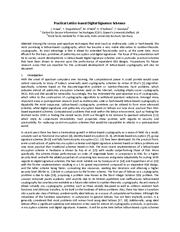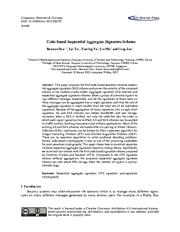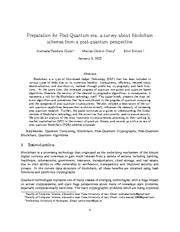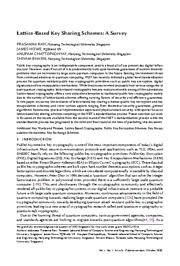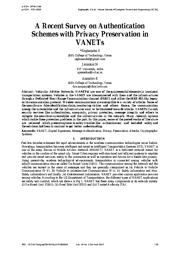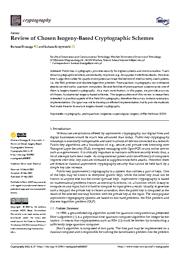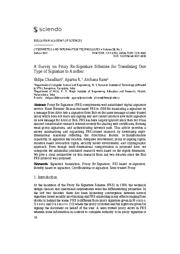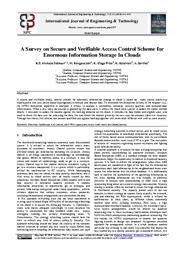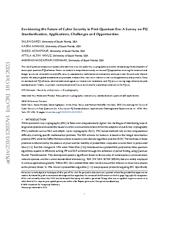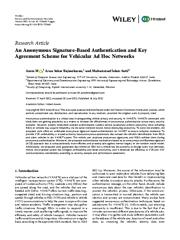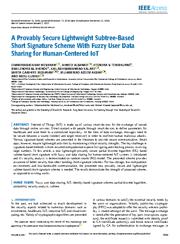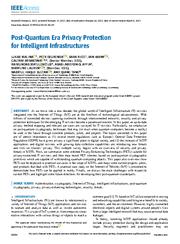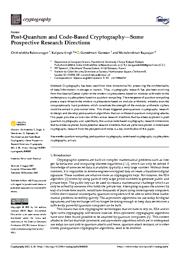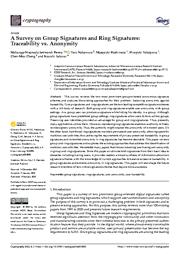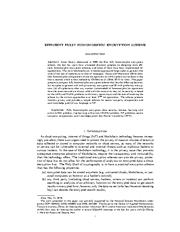A copy of this work was available on the public web and has been preserved in the Wayback Machine. The capture dates from 2017; you can also visit the original URL.
The file type is application/pdf.
Filters
Practical Lattice-Based Digital Signature Schemes
2015
ACM Transactions on Embedded Computing Systems
The focus of this presentation will be to survey recent developments in lattice-based digital signature schemes and in particular practical schemes that have been shown to improve upon the performance ...
Among the various post-quantum techniques that exist (such as multivariate, code or hash-based), the most promising is lattice-based cryptography, which has become a very viable alternative to number-theoretic ...
Table I : I A summary of lattice-based DSSs and schemes based on classical assumptions. Scheme
Security
Sign. Size
sk Size
pk Size
Sign./s
Ver. ...
doi:10.1145/2724713
fatcat:2cck3r7y3rb7jghfuinosibixu
Code-based Sequential Aggregate Signature Scheme
2022
Computers Materials & Continua
This paper proposes the first code-based quantum immune sequential aggregate signature (SAS) scheme and proves the security of the proposed scheme in the random oracle model. ...
Aggregate signature (AS) schemes and sequential aggregate signature schemes allow a group of potential signers to sign different messages respectively, and all the signatures of those users on those messages ...
Due to the anti-quantum of the CFS signature schemes [16, 17] , to the best knowledge we know, our scheme is the first code-based quantum immune sequential aggregate signature (SAS) scheme. ...
doi:10.32604/cmc.2022.030270
fatcat:odonajohifab7muk3v2van6vz4
Preparation for Post-Quantum era: a survey about blockchain schemes from a post-quantum perspective
[article]
2022
IACR Cryptology ePrint Archive
At the same time, the increased progress of quantum computers and quantum-based algorithms threatens the security of the classical cryptographic algorithms, in consequence, it represents a risk for the ...
(PQB) schemes proposals. ...
] : In the article of Gao et.al. [99] , the authors propose a lattice-based signature scheme with respect to their declared goal of developing a quantum-resilient scheme. ...
dblp:journals/iacr/CiuleiCS22
fatcat:dw3z6d6nnfc7lll55dwejilg5a
Lattice-based Key Sharing Schemes - A Survey
[article]
2020
IACR Cryptology ePrint Archive
Lattice-based cryptography offers a very attractive alternative to traditional public-key cryptography mainly due to the variety of lattice-based schemes offering varying flavors of security and efficiency ...
In this paper, we survey the evolution of lattice-based key sharing schemes (public key encryption and key encapsulation schemes) and cover various aspects ranging from theoretical security guarantees, ...
[88] proposed a comprehensive survey of lattice-based digital signature schemes in 2015 and Nejatollahi et al. ...
dblp:journals/iacr/RaviHCB20
fatcat:gwfp7xfzbbgxnldzbngfc4ru7q
A Recent Survey on Authentication Schemes with Privacy Preservation in VANETs
2019
Indian Journal of Computer Science and Engineering
Wireless communications are susceptible to a variety of attacks. Some of the assaults are false identification claim, monitoring victims and others. ...
VANETs furnish security services like authentication, anonymity, privacy protection, message integrity and others to mitigate the assaults on automobiles and the infrastructures in the network. ...
Based on the lattice-based signature scheme, a secure, nameless authentication scheme is constructed which affords privacy-preserving V2I and V2V communications besides TPDs. ...
doi:10.21817/indjcse/2019/v10i5/191005034
fatcat:vzxzb3qzbrgnlellcpugk36gs4
Review of Chosen Isogeny-Based Cryptographic Schemes
2022
Cryptography
As a main contribution, in this paper, we provide a survey of chosen, fundamental isogeny-based schemes. ...
Post-quantum cryptography can withstand attacks carried out by quantum computers. Several families of post-quantum systems exist; one of them is isogeny-based cryptography. ...
Security of the Chosen Schemes In this article, we do not repeat security proofs of the schemes we survey. ...
doi:10.3390/cryptography6020027
fatcat:jfwtotts7vbs3jbjpduz2ylljm
A Survey on Proxy Re-Signature Schemes for Translating One Type of Signature to Another
2021
Cybernetics and Information Technologies
location, delegatee involvement, proxy re-signing rights, duration-based revocation rights, security model environment, and cryptographic approach. ...
This article provides a survey summarizing and organizing PRS-related research by developing eight-dimensional taxonomy reflecting the directional feature, re-transformation capability, re-signature key ...
Identity-based PRS from Lattice assumptions (IPRS-L) is the first quantum age related scheme that is proven secure under conventional Small Integer Solution (SIS) assumption (T i a n [49] ). ...
doi:10.2478/cait-2021-0028
fatcat:47x4h2numbgx5duo6sdbcaqake
A Survey on Secure and Verifiable Access Control Scheme for Enormous Information Storage In Clouds
2018
International Journal of Engineering & Technology
A secure and verifiable access control scheme for enormous information storage in cloud is based on open source public-key cryptosystem that uses lattice-based cryptography to encrypt and decrypt data ...
It allows to analyze it correctness, accuracy, security qualities and computational effectiveness. When a new entry permission is granted by the data users. ...
A secure and verifiable access control scheme for enormous information storage in cloud is based on NTRU cryptosystem. ...
doi:10.14419/ijet.v7i3.27.17986
fatcat:bhm63irzn5hpdhkjg32omz26xu
Envisioning the Future of Cyber Security in Post-Quantum Era: A Survey on PQ Standardization, Applications, Challenges and Opportunities
[article]
2023
arXiv
pre-print
The rise of quantum computers exposes vulnerabilities in current public key cryptographic protocols, necessitating the development of secure post-quantum (PQ) schemes. ...
Hence, we conduct a comprehensive study on various PQ approaches, covering the constructional design, structural vulnerabilities, and offer security assessments, implementation evaluations, and a particular ...
Section 3 forms the evaluative nucleus of this survey, wherein the diverse range of approaches, inclusive of lattice-based, hash-based, code-based, multivariate, isogeny-based, symmetric key-based, miscellaneous ...
arXiv:2310.12037v1
fatcat:wdb6cdryqfby3dbnqna3e4xoja
An Anonymous Signature-Based Authentication and Key Agreement Scheme for Vehicular Ad Hoc Networks
2022
Security and Communication Networks
VANETs connected with blockchain are gaining popularity as a means to increase the effectiveness of anonymous authentication across many security domains. ...
Moreover, the proposed authentication methods are based on an anonymous certificateless signature (ACS) approach that is computationally more efficient and provably safe against eternal forgery in the ...
Later, the authors revised this paper in 2008 [8] , proposing an id-based secure group key agreement approach to safeguard against impersonation security assaults. However, Wu et al. ...
doi:10.1155/2022/1222660
fatcat:nlp72zbsjjehvj7ufnzbmenjju
A Provably Secure Lightweight Subtree-based Short Signature Scheme with Fuzzy User Data Sharing for Human-Centered IoT
2020
IEEE Access
The presented scheme provides assurance of better security than other standing short-signature schemes. ...
In this article, a new lightweight provably secure partial discrete logarithm (DL) based subtree-based short signature with fuzzy user data sharing for human-centered IoT systems is introduced and it's ...
ACKNOWLEDGMENT The authors are grateful to the Deanship of Scientific Research, King Saud University for funding through Vice Deanship of Scientific Research Chairs. ...
doi:10.1109/access.2020.3046367
fatcat:pj73p3vvubdjjodpvl73u52m4m
Post-Quantum Era Privacy Protection for Intelligent Infrastructures
2021
IEEE Access
This in-depth survey begins with an overview of security and privacy threats in IoT/IIs. ...
Next, we summarize some selected Privacy-Enhancing Technologies (PETs) suitable for privacy-concerned II services, and then map recent PET schemes based on post-quantum cryptographic primitives which are ...
Since this first lattice-based blind signature scheme, quantum-resistant blind signatures have been constructed by using various post-quantum approaches, e.g. multivariate-based [238] , code-based [239 ...
doi:10.1109/access.2021.3062201
fatcat:kqcwwqjfjnds7bzlrid7r6gjlu
Post-Quantum and Code-Based Cryptography—Some Prospective Research Directions
2021
Cryptography
The emergence of quantum computing poses a major threat to the modern cryptosystems based on modular arithmetic, whereby even the computationally hard problems which constitute the strength of the modular ...
Some potential research directions that are yet to be explored in code-based cryptography research from the perspective of codes is a key contribution of this paper. ...
Acknowledgments: This research work has been carried out under the leadership of the Institute for Technological Research SystemX, and therefore granted within the scope of the program "Recherche Exploratoire ...
doi:10.3390/cryptography5040038
fatcat:wkb43zunwjagbnljc6brfou4ty
A Survey on Group Signatures and Ring Signatures: Traceability vs. Anonymity
2022
Cryptography
This survey reviews the two most prominent group-oriented anonymous signature schemes and analyzes the existing approaches for their problem: balancing anonymity against traceability. ...
Group signatures and ring signatures are the two leading competitive signature schemes with a rich body of research. Both group and ring signatures enable user anonymity with group settings. ...
Thus, lattice-based [25, 34] and code-based [35] quantum-safe group signatures were subsequently presented to secure group signatures in the future. ...
doi:10.3390/cryptography6010003
fatcat:dby2hr4g4zhqtemdm3tm43552u
Efficient Fully Homomorphic Encryption Scheme
[article]
2018
IACR Cryptology ePrint Archive
The scheme protects function privacy and provides a simple solution for secure two-party computation and zero knowledge proof of any language in NP. ...
keys) and the cost of breaking the scheme by the current approaches is at least 2 160 bit operations. ...
On the theoretical side, there are still many open problems, including solving LWE problems and lattice basis problems, and there is a great need for more careful studying of attacks based on lattice basis-reduction ...
dblp:journals/iacr/Gao18
fatcat:w3mosddnubcwxgk25wwssgejha
« Previous
Showing results 1 — 15 out of 1,059 results

